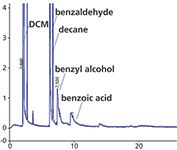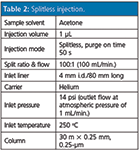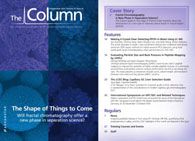The LCGC Blog: Capillary GC Liner Selection Guide
LCGC Blogger Tony Taylor provides his impartial guide to liner selection that is representative of the considerations in modern capillary gas chromatography (GC).
LCGC blogger Tony Taylor provides his impartial guide to liner selection that is representative of the considerations in modern capillary gas chromatography (GC).
I've always thought that creating a simple guide to liner selection for capillary gas chromatography (GC) was a good idea. The internet is packed with information from vendors on which type of liner to use, but they do have a tendency to push their latest design or explain the function of a whole bunch of historical designs that are frankly no longer relevant because of improvements in instrument or liner design. This blog entry therefore attempts to provide an impartial guide to liner selection that is representative of the considerations in modern capillary GC.

(PHOTO CREDIT: ANDY ROBERTS/GETTY IMAGES)
A liner is typically constructed of quartz glass with a tubular device residing within the vaporizing GC inlet to perform one, or a combination of, the following functions:
- Provide an inert area in which the sample can become volatile.
- Facilitate transfer of the sample either into the column or out of the split line.
- Ensure efficient, quantitative transfer of all sample components into the column.
Here is what we need to avoid when selecting an appropriate liner:
- Contribution to sample degradation.
- Contributes unwanted secondary retention (adsorption) mechanisms for some or all sample components.
- Contributes excess dead volume into the system, which leads to unnecessary peak broadening (loss of efficiency).
- Gives rise to sample backflash through inadequate internal volume.
I've used some specific examples below that give an indication of the potential thought processes for selecting an appropriate liner.

Table 1: Split injection.
Split Injection
The residence time of the sample within the liner (t) under the split injection conditions shown in Table 1 is given by:



Figure 1: Default liner for splitless injections.
Now:

The default liner for splitless injection is usually a straight-through deactivated liner with no packing material, as shown in Figure 1. As we have seen, splitless injections occur quickly with the vaporized sample being rapidly transported into the column, resulting in narrow (efficient) analyte peaks. A straight-through liner allows rapid sample vapour transfer into the column. One should take care to ensure the position of the column within the inlet is in compliance with the manufacturers instructions.
The liner should be deactivated to remove any silanol species on the quartz (silica) glass surface that may give rise to secondary interactions between polar analytes and the liner surface. Secondary interactions can result in a reduction in sensitivity for the analytes involved, poor peak area reproducibility, and peak tailing. Manufacturers of liners and capillary GC columns have developed highly sophisticated deactivation treatments to ensure the very lowest levels of analyte adsorption and the best peak shapes possible. However, if peak area reproducibility is poor, or if inlet discrimination is suspected, glass wool may be added to assist with the sample volatilization and mixing.

Figure 2: Good peak shape for non-polar analytes and tailing of polar analytes indicates that secondary retention mechanisms are in play.
Figure 4 shows the positioning of deactivated quartz wool, so that the autosampler syringe penetrates the plug during injection. The mass and density of glass wool is important. The glass wool is held in place by the baffles either side of the plug. An open bottom design ensures fast mass transfer of sample vapours into the column. Some designs have a quartz glass "button" on the lower rim to stop the liner from resting on the bottom surface of the inlet, avoiding peak shape deformations and poor reproducibility in some instrument designs.

Figure 3: Typical deactivation reaction of the quartz galss surface using DCMS.
Higher boiling analytes may pass the split point (column entrance) in the liquid state or, following vaporization, associate with the liner walls rather than the middle of the liner (where the column is positioned) and be lost from the split line. This then gives a falsely low response for later eluting compounds. In Figure 5 all analytes are present in this sample of n-alkanes at equal concentration. Lower analyte response for higher mass analytes is caused by inlet discrimination. The use of a deactivated glass wool plug positioned within the liner to wipe the tip of the injection syringe during injection, gives the following advantages:
- It promotes mixing to improve injection reproducibility and minimize mass discrimination as a result of wall effects.
- It provides a large surface area from which higher boiling analytes can evolve into the gas phase, again reducing mass discrimination.
- It wipes the needle tip and prevents needle discrimination as a result of condensation of higher boiling analytes onto the needle outer surface.
- It prevents the analyte from contacting the bottom of the liner (preventing poor peak shape and compromised quantitation when dealing with thermally labile analytes).
- It prevents involatile materials (sample components/septum shards) from contaminating the inlet / column.

Figure 4: Deactivated quartz glass.
Sometimes the use of deactivated quartz wool can cause issues with highly adsorptive compounds in which case other liner packings such as carboxen and other highly inactive materials should be considered.

Figure 5: Sample of n-alkanes at equal concentration.
If the use of a glass wool plug doesn't solve your poor quantitative reproducibility problems, or if you are having problems with carryover, try the following quick check. To calculate the liner volume (V) use:

This is unless the liner has baffles, glass wool, or restrictions, in which case your manufacturer should provide you with these details.
When the solvent density is known and under given temperature and pressure conditions we can calculate the volume of vapour formed on

V1 = injection volume (µL), D = sample solvent density (g/mL), MW = molecular weight of sample solvent, T = inlet temperature (°C), Pi = inlet pressure, P0 = atmospheric pressure.

There are several good freely available calculators:
If the volume of sample vapour produced exceeds the liner volume, sample will be carried to and deposited in the lower temperature parts of the GC tubing. This is sometimes referred to as "backflash" and is the primary cause of poor quantitative reproducibility and sample carryover — when you get a miniversion of your previous sample chromatogram in a blank injection. To ensure backflash does no occur, check that the volume of the sample vapour produced is less than 75% of the liner internal volume.
Under the conditions of our split method above, the volume of sample vapour produced is 583 µL (less than 75% of the total liner volume of 1005 µL).
Some folks like to use an upper gooseneck within the liner to restrict the flow of excess sample vapours out of the top of the liner (Figure 6). This approach should be avoided and steps taken to reduce the amount of sample vapour formed by reducing injection volume, changing solvent, or using a pressure pulse during the injection phase.

Figure 6: A liner with an upper gooseneck.
Splitless Injection
The residence time of the sample within the liner (t), under the splitless injection conditions shown in Table 2 is given by:



As might be expected, the theoretical vapour residence time of the sample within the inlet is now much longer in this splitless injection, because of the much lower liner carrier gas flow rate. The sample needs to be protected the sample from contacting the lower, hot metal surface of the inlet, otherwise we get "chair-shaped" peak deformations as shown in Figure 7 and poor peak area reproducibility because of sample thermal decomposition.

Table 2: Splitless injection.
Typically, splitless liners have a lower gooseneck that restricts access to the hot metal surfaces in the lower part of the liner and acts to "funnel" the analyte components into the mouth of the capillary column (Figure 8).

Figure 7: Example of "chair-shaped" peak deformations.
For all of the reasons cited in the previous section, splitless injection liners also tend to be packed with deactivated glass wool to aid sample mixing and prevent discrimination effects. In splitless injection, the glass wool also acts to protect the column from contamination by less volatile components of the sample, which would otherwise all be entrained into the head of the analytical column.

Figure 8: A splitless liner with a lower gooseneck.
Many other liner designs are available; however, in modern GC those which are described above will satisfy the majority of applications.
E-mail: bev@crawfordscientific.com / colin@crawfordscientific.com
Website: www.chromacademy.com
This article is from The Column. The full issue can be found here:http://images2.advanstar.com/PixelMags/lctc/digitaledition/September08-2014-uk.html#2

The LCGC Blog: Historical (Analytical) Chemistry Landmarks
November 1st 2024The American Chemical Society’s National Historic Chemical Landmarks program highlights sites and people that are important to the field of chemistry. How are analytical chemistry and separation science recognized within this program?







